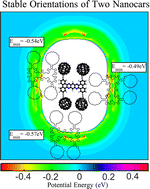Nanocar swarm movement on graphene surfaces†
Abstract
Investigation of nanomachine swarm motion is useful in the design of molecular transportation systems as well as in understanding the assembly process on the surface. Here, we evaluate the motion of the clusters of nanocars on graphene surfaces, using molecular dynamics (MD) simulations. The mechanism of motion of single nanocars is evaluated by considering the rotation of the wheels, direction of the nanocars’ speed and comparing the characteristics of the surface motion of nanocars and similar absorbed molecules. The mentioned analyses reveal that, in the thermally activated surface motion of the nanocars, sliding movements are the dominant mode of motion. A coarse grained (CG) model is proposed for some preliminary studies such as finding the stable orientation of two nanocars. The established model indicates three stable orientations for a pair of nanocars, which are verified by MD simulations and the analysis of potential energy. The radius of gyration and the root mean square deviation (RMSD) are employed to evaluate the configuration of larger nanocar clusters. Nanocar clusters change their configuration at 300 K and higher temperatures; however, there is a threshold temperature (600 K) at which different clusters are broken because at this temperature the thermal fluctuation energy dominates the vdW attraction between a nanocar in the perimeter and the other nanocars of the cluster. The surface motions of the nanocar clusters are investigated at temperatures at which the clusters are thermally stable by computing different motion parameters such as mean square displacements (MSDs), diffusion coefficients and anomaly parameters. As the population of clusters increases from 1 to 10 nanocars, the motion regime changes from long-range to small-range displacements which is attributed to the energy wasted by intermolecular vdW interactions. The anomaly parameters of the motions reveal that the clusters experience almost normal diffusion at low temperatures, while they find a super-diffusive regime at higher temperatures. Ultimately, the preferred arrangement of nanocar assembly can be utilized to fabricate special nanostructures on the surface including molecular rings and chains.



 Please wait while we load your content...
Please wait while we load your content...